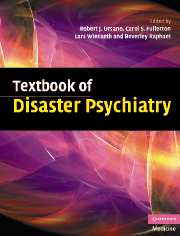Book contents
- Frontmatter
- Contents
- List of contributors
- Preface
- Part I Introduction
- Part II Foundations of disaster psychiatry
- Part III Clinical care and interventions
- Part IV Special topics
- Part V Public health and disaster psychiatry
- 15 Public health and disaster mental health: preparing, responding, and recovering
- Index
- References
15 - Public health and disaster mental health: preparing, responding, and recovering
from Part V - Public health and disaster psychiatry
Published online by Cambridge University Press: 09 August 2009
- Frontmatter
- Contents
- List of contributors
- Preface
- Part I Introduction
- Part II Foundations of disaster psychiatry
- Part III Clinical care and interventions
- Part IV Special topics
- Part V Public health and disaster psychiatry
- 15 Public health and disaster mental health: preparing, responding, and recovering
- Index
- References
Summary
Mental health experts are an essential part of planning for and responding to disasters. However, across nations, public mental health planning and care vary greatly from systems in which all healthcare is national and resources are substantial, to those in which no mental healthcare is available or the public resources are greatly limited. Regardless of resources, disasters challenge mental health systems in nearly all nations and communities.
In the United States, prior to the 1960s the mental health component of the public health system generally meant public mental hospitals. Beginning in the 1960s and continuing to the early 1970s, the public health-mental health system was the community mental health center. The early 1970s saw the start of a continuous erosion in the comprehensive mission originally included as part of community mental health. Today, with rare exception, the public health component of the United States mental health system refers to community based services for people with serious and persistent mental illness, not to a comprehensive public health approach to the entire mental health and behavioral needs of the community (Institute of Medicine, 2003). There is not a systematic approach to the provision of public medical care for mental health problems across the entire range of primary, secondary, and tertiary prevention including health behaviors and traditional mental health – from community-based prevention programs to outpatient clinics, inpatient hospital care, and care in the primary care setting where most mental health problems present.
Keywords
- Type
- Chapter
- Information
- Textbook of Disaster Psychiatry , pp. 311 - 326Publisher: Cambridge University PressPrint publication year: 2007
References
- 3
- Cited by



